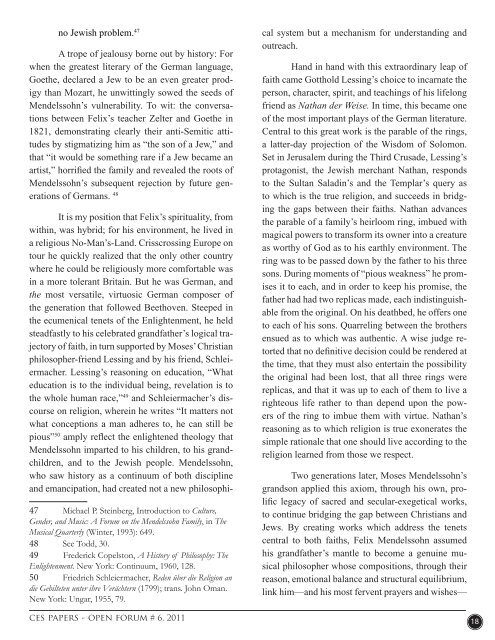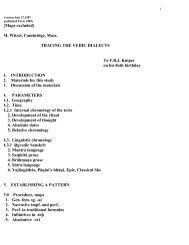references - people.fas.harvard.edu - Harvard University
references - people.fas.harvard.edu - Harvard University
references - people.fas.harvard.edu - Harvard University
Create successful ePaper yourself
Turn your PDF publications into a flip-book with our unique Google optimized e-Paper software.
no Jewish problem. 47<br />
A trope of jealousy borne out by history: For<br />
when the greatest literary of the German language,<br />
Goethe, declared a Jew to be an even greater prodigy<br />
than Mozart, he unwittingly sowed the seeds of<br />
Mendelssohn’s vulnerability. To wit: the conversations<br />
between Felix’s teacher Zelter and Goethe in<br />
1821, demonstrating clearly their anti-Semitic attitudes<br />
by stigmatizing him as “the son of a Jew,” and<br />
that “it would be something rare if a Jew became an<br />
artist,” horrifi ed the family and revealed the roots of<br />
Mendelssohn’s subsequent rejection by future generations<br />
of Germans. 48<br />
It is my position that Felix’s spirituality, from<br />
within, was hybrid; for his environment, he lived in<br />
a religious No-Man’s-Land. Crisscrossing Europe on<br />
tour he quickly realized that the only other country<br />
where he could be religiously more comfortable was<br />
in a more tolerant Britain. But he was German, and<br />
the most versatile, virtuosic German composer of<br />
the generation that followed Beethoven. Steeped in<br />
the ecumenical tenets of the Enlightenment, he held<br />
stead<strong>fas</strong>tly to his celebrated grandfather’s logical trajectory<br />
of faith, in turn supported by Moses’ Christian<br />
philosopher-friend Lessing and by his friend, Schleiermacher.<br />
Lessing’s reasoning on <strong>edu</strong>cation, “What<br />
<strong>edu</strong>cation is to the individual being, revelation is to<br />
the whole human race,” 49 and Schleiermacher’s discourse<br />
on religion, wherein he writes “It matters not<br />
what conceptions a man adheres to, he can still be<br />
pious” 50 amply refl ect the enlightened theology that<br />
Mendelssohn imparted to his children, to his grandchildren,<br />
and to the Jewish <strong>people</strong>. Mendelssohn,<br />
who saw history as a continuum of both discipline<br />
and emancipation, had created not a new philosophi-<br />
47 Michael P. Steinberg, Introduction to Culture,<br />
Gender, and Music: A Forum on the Mendelssohn Family, in The<br />
Musical Quarterly (Winter, 1993): 649.<br />
48 See Todd, 30.<br />
49 Frederick Copelston, A History of Philosophy: The<br />
Enlightenment. New York: Continuum, 1960, 128.<br />
50 Friedrich Schleiermacher, Reden über die Religion an<br />
die Gebilteten unter ihre Verächtern (1799); trans. John Oman.<br />
New York: Ungar, 1955, 79.<br />
ces papers - open forum # 6, 2011<br />
cal system but a mechanism for understanding and<br />
outreach.<br />
Hand in hand with this extraordinary leap of<br />
faith came Gotthold Lessing’s choice to incarnate the<br />
person, character, spirit, and teachings of his lifelong<br />
friend as Nathan der Weise. In time, this became one<br />
of the most important plays of the German literature.<br />
Central to this great work is the parable of the rings,<br />
a latter-day projection of the Wisdom of Solomon.<br />
Set in Jerusalem during the Third Crusade, Lessing’s<br />
protagonist, the Jewish merchant Nathan, responds<br />
to the Sultan Saladin’s and the Templar’s query as<br />
to which is the true religion, and succeeds in bridging<br />
the gaps between their faiths. Nathan advances<br />
the parable of a family’s heirloom ring, imbued with<br />
magical powers to transform its owner into a creature<br />
as worthy of God as to his earthly environment. The<br />
ring was to be passed down by the father to his three<br />
sons. During moments of “pious weakness” he promises<br />
it to each, and in order to keep his promise, the<br />
father had had two replicas made, each indistinguishable<br />
from the original. On his deathbed, he offers one<br />
to each of his sons. Quarreling between the brothers<br />
ensued as to which was authentic. A wise judge retorted<br />
that no defi nitive decision could be rendered at<br />
the time, that they must also entertain the possibility<br />
the original had been lost, that all three rings were<br />
replicas, and that it was up to each of them to live a<br />
righteous life rather to than depend upon the powers<br />
of the ring to imbue them with virtue. Nathan’s<br />
reasoning as to which religion is true exonerates the<br />
simple rationale that one should live according to the<br />
religion learned from those we respect.<br />
Two generations later, Moses Mendelssohn’s<br />
grandson applied this axiom, through his own, prolifi<br />
c legacy of sacred and secular-exegetical works,<br />
to continue bridging the gap between Christians and<br />
Jews. By creating works which address the tenets<br />
central to both faiths, Felix Mendelssohn assumed<br />
his grandfather’s mantle to become a genuine musical<br />
philosopher whose compositions, through their<br />
reason, emotional balance and structural equilibrium,<br />
link him—and his most fervent prayers and wishes—<br />
18

















